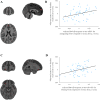Is brain response to food rewards related to overeating? A test of the reward surfeit model of overeating in children
- PMID: 29890186
- PMCID: PMC7482544
- DOI: 10.1016/j.appet.2018.06.014
Is brain response to food rewards related to overeating? A test of the reward surfeit model of overeating in children
Abstract
The reward surfeit model of overeating suggests that heightened brain response to rewards contributes to overeating and subsequent weight gain. However, previous studies have not tested whether brain response to reward is associated with food intake, particularly during childhood, a period of dynamic development in reward and inhibitory control neurocircuitry. We conducted functional magnetic resonance imaging (fMRI) with 7-11-year-old children (n = 59; healthy weight, n = 31; overweight, n = 28; 54% female) while they played a modified card-guessing paradigm to examine blood-oxygen-level-dependent (BOLD) response to anticipating and winning rewards (food, money, neutral). Food intake was assessed at three separate meals that measured different facets of eating behavior: 1) typical consumption (baseline), 2) overindulgence (palatable buffet), and 3) eating in the absence of hunger (EAH). A priori regions of interest included regions implicated in both reward processing and inhibitory control. Multiple stepwise regressions were conducted to examine the relationship between intake and BOLD response to rewards. Corrected results showed that a greater BOLD response in the medial prefrontal cortex for anticipating food compared to money positively correlated with how much children ate at the baseline and palatable buffet meals. BOLD response in the dorsolateral prefrontal cortex for winning food compared to money was positively correlated with intake at the palatable buffet meal and EAH. All aforementioned relationships were independent of child weight status. Findings support the reward surfeit model by showing that increased brain response to food compared to money rewards positively correlates with laboratory measures of food intake in children.
Trial registration: ClinicalTrials.gov NCT02855398.
Keywords: Childhood obesity; Eating behavior; Inhibitory control; Reward processing; fMRI.
Copyright © 2018. Published by Elsevier Ltd.
Conflict of interest statement
No authors report any conflicts of interest.
Figures




References
-
- Adise S, Geier CF, Roberts NR, White CN, Keller KL. Food or money? Children’s brains respond differently to rewards regardless of weight status. Pediatric Obesity. 2018 Under Review. - PubMed
Publication types
MeSH terms
Associated data
Grants and funding
LinkOut - more resources
Full Text Sources
Other Literature Sources
Medical
Research Materials

